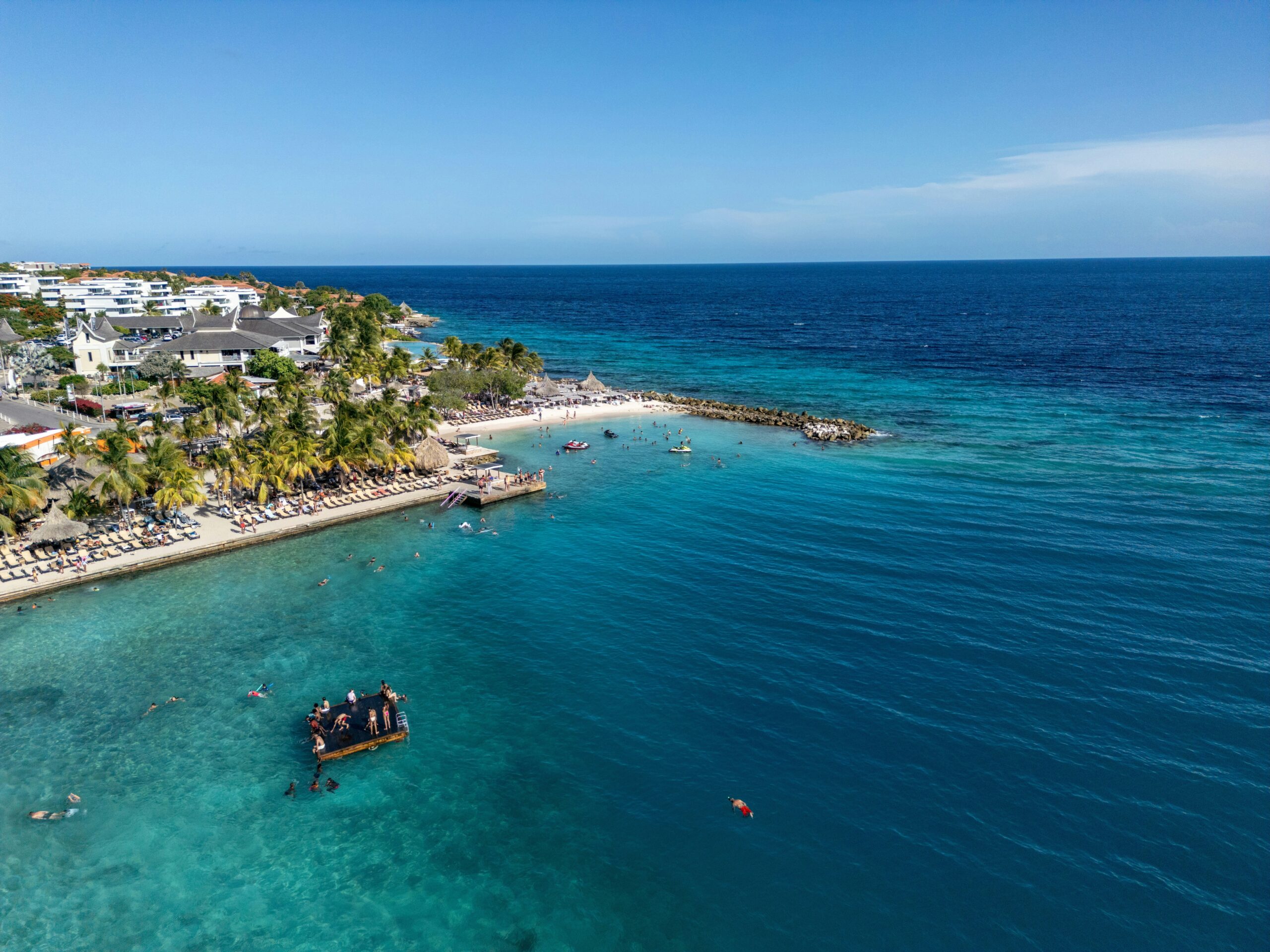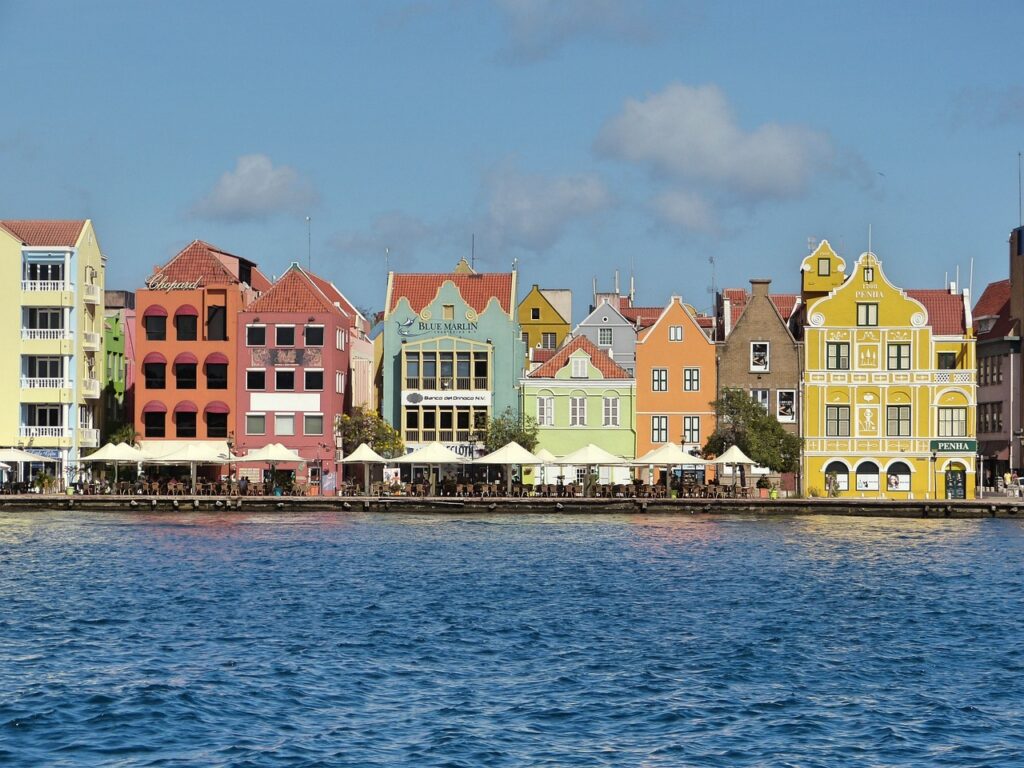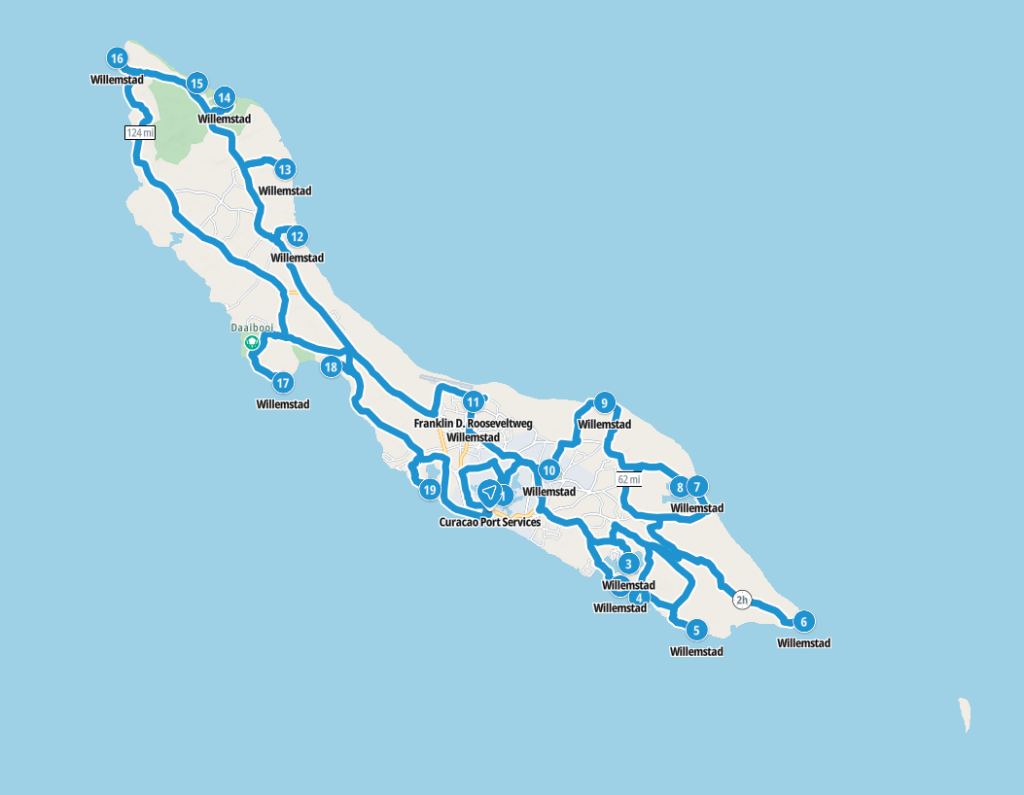Curaçao / Land Curaçao / Pais Kòrsou – Let’s explore here
What’s it like in Curaçao?
Curaçao is an island located in the Caribbean Sea in South America. It is part of the Netherlands, although it’s not part of the EU. Curaçao has a population of around 156,000 people (2023), about 90% of whom live in the capital city, Willemstad.
The island lies about 40 miles (65 km) from the coast of Venezuela, and is mostly flat with some rolling hills. The highest peak is Mount Christoffelberg, at 1,220 ft (372 m) above sea level. There is a small uninhabited island off the coast of Curaçao called Klein Curaçao, which is popular with tourists because of its pristine white beaches.
Although Curaçao relies heavily on tourism like many other Caribbean islands, it is also a tax haven.

A bit about the history Curaçao
Early History and Indigenous People
Curaçao, an island in the southern Caribbean, was originally inhabited by the Arawak and Carib peoples, who lived on the island for centuries before European arrival. These indigenous groups practiced agriculture, fishing, and pottery-making. When European explorers arrived, they encountered these well-established communities.
European Discovery and Dutch Control
In 1499, Spanish explorer Alonso de Ojeda was the first European to land on Curaçao. The Spanish initially colonised the island but found it difficult to maintain a settlement due to the island’s lack of precious metals. In 1634, the Dutch West India Company took control of Curaçao from the Spanish, and the island became part of the Dutch Caribbean empire.
Slavery and Economic Development
The Dutch introduced African slavery to Curaçao, using enslaved Africans for labour on plantations and in the salt industry. The island became a crucial trading post in the transatlantic slave trade and played a significant role in supplying the Dutch with labour for their colonies in the Americas. Curaçao also became an important center for the Dutch West India Company’s operations in the Caribbean, particularly in the trade of slaves, sugar, and other goods.
British and French Occupations
During the 18th century, Curaçao was occasionally occupied by British and French forces, reflecting the island’s strategic importance in the Caribbean. However, the Dutch managed to regain control after each occupation, and Curaçao remained a key part of the Dutch colonial empire throughout this period. The economy continued to rely on trade, shipping, and the production of salt and goods.
The 19th Century and Abolition of Slavery
In the 19th century, Curaçao’s economy remained tied to the slave trade and plantation agriculture. The abolition of slavery in the Dutch colonies in 1863 marked a turning point for the island. After emancipation, many former slaves continued to work on the island, while others migrated. Curaçao’s economy gradually shifted from agriculture to services, including oil refining.
20th Century and Economic Growth
In the early 20th century, Curaçao saw significant economic growth due to the establishment of oil refineries, particularly the Royal Dutch Shell refinery, which transformed the island into a vital industrial hub. The island also became a major financial center in the Caribbean. In the mid 1900s, tourism began to develop, with Curaçao attracting visitors due to its natural beauty, culture, and colonial architecture.
Political Status and Modern Era
In 1954, Curaçao became part of the Netherlands Antilles, a federation of Dutch Caribbean islands. The Netherlands Antilles was dissolved in 2010, and Curaçao became a constituent country within the Kingdom of the Netherlands, gaining more self-governance while remaining under the Dutch monarchy. Today, Curaçao is an autonomous country with its own government, but it still relies on the Kingdom of the Netherlands for defense and foreign policy. The island’s economy is driven by tourism, oil refining, finance, and trade. It continues to be a popular destination for tourists, known for its vibrant culture, colorful architecture, and thriving marine life.

Curaçao road trip
Curaçao is our second planned stop on our road trip through the islands of the Caribbean. Having explored Aruba, our next stop is Bonaire.
Travelling overland between the islands is quite prohibitive due to the lack of transportation options. Travelling between different island countries via ferry is possible, however, ferries only operate between some islands. Chartering private boats between islands is also possible, although travelling with a car in this way is prohibitive. Flying is another option, although again, flights only operate between some islands.
Map of our road trip through Curaçao

This is a map of our planned route around the island of Curaçao, starting and ending in the port.
Weather in Curaçao
When is the best time to visit Curaçao?
The best time to visit Curaçao is from January to May. During these months, the islands have 8 – 9 hours of sunshine per day and rainfall of 0.6 – 1.8 inches (14 – 45mm) per month. The temperature ranges from 24 – 32°C (76 – 90°F).
When is the worst time to visit Curaçao?
The worst time to visit Curaçao is from July to December. During these months, the islands still have 8 – 10 hours of sunshine per day. However, humidity rises and it rains an average of 1.6 – 4.7 inches (40 – 120mm) per month. The temperature ranges from 26 – 33°C (78 – 92°F).
Hurricane Season in the Caribbean
Hurricane season in the Caribbean runs from June 1 to November 30. Storms tend to be more frequent and more severe in the latter half of the season.
Hurricanes are least likely during December, January and February.
Travel in and around Curaçao
Ferries to and from Curaçao
The Bonaire Ferry travels between Curaçao and Bonaire daily.
There are a number of water taxis that travel between Curaçao and Klein Curaçao daily.
What’s it like to drive in Curaçao?
They drive on the right hand side of the road in Curaçao. In the main, roads are in fairly good condition, with some smaller roads being dirt tracks.
Do you require an international driving permit in Curaçao?
We’ve created a dedicated page to driving abroad, which answers this question, and more, which you might find helpful.
Can you use your UK driving license when driving through Curaçao?
We’ve created a dedicated page to driving abroad, which answers this question, and more, which you might find helpful.
Do I need a carnet de passages to drive in Curaçao?
We’ve created a dedicated page to driving abroad, which answers this question, and more, which you might find helpful.
What are the speed limits in Curaçao?
The speed limits for cars in Curaçao are:
- 25 mph (40 km/h) for urban driving
- 35 mph (60 km/h) outside of built up areas
- 35 mph (60 km/h) on dual carriageways
- 35 mph (60 km/h) on motorways
What currency do they use in Curaçao?
In Curaçao they use the Netherlands Antillean guilder, although the US dollar is widely accepted. Cash is widely used. The use of credit / debit cards is widely accepted in tourist areas. Travellers cheques are not generally accepted. There are many ATMs in tourist areas, although not all accept foreign issued cards.
You should make yourself aware of the amount that your bank charges you for using credit and debit cards abroad. Often credit cards are cheaper for purchasing items directly, and for withdrawing cash from ATMs.
What language do they speak in Curaçao?
They speak Dutch, English and Spanish Creole in Curaçao. Spanish is also spoken widely.
What time zone is Curaçao in?
Remember, when you’re planning your next trip to take a look at what time zone it’s in.
Do I need a visa to visit Curaçao?
We’ve created a dedicated, more comprehensive page on visas, which you should find helpful. Check it out!
Is wild camping legal in Curaçao?
No, wild camping is illegal in Curaçao.
What plug / socket type do they use in Curaçao?
In Curaçao they use plug / socket types A, B and F.



Health Issues in Curaçao
Is it safe to drink water in Curaçao?
Yes, it is safe to drink tap water in Curaçao. Bottled water is also readily available across the country.
What vaccinations are required for Curaçao?
This NHS website is kept up to date with all relevant information on vaccinations in Curaçao.
Phones in Curaçao
What is the country calling code for Curaçao?
The country calling code for Curaçao is +5999
What are the emergency phone numbers in Curaçao?
- The emergency number for police in Curaçao is: 911
- In Curaçao, the emergency number for ambulance is: 912
- The emergency number for fire in Curaçao is: 911
If you’ve got some useful info that you’d like to share, let us know!
And don’t forget to check out all the other pictures!
